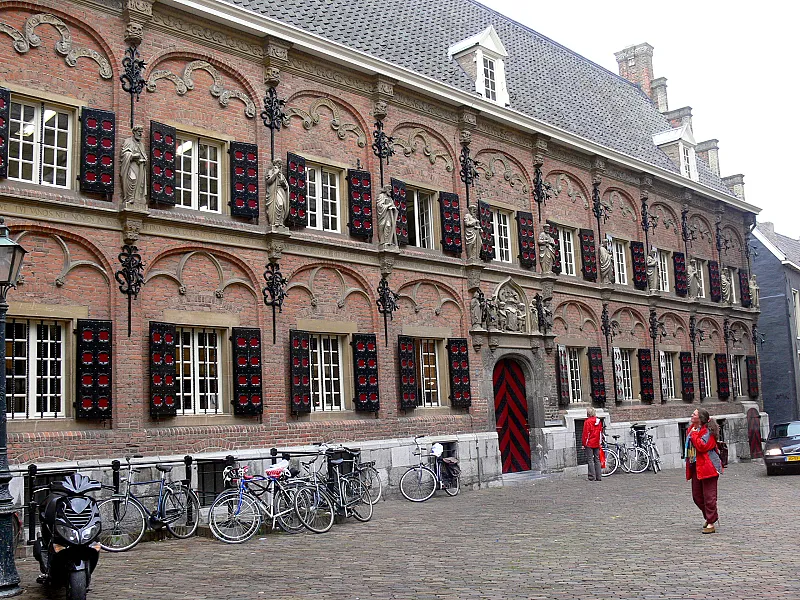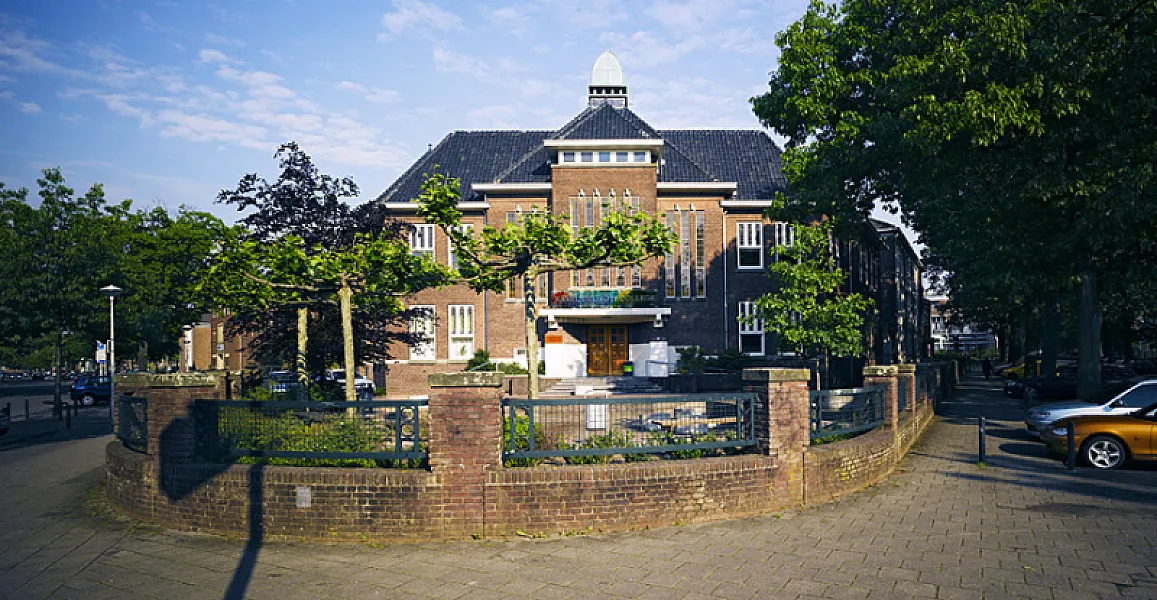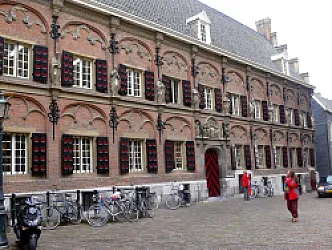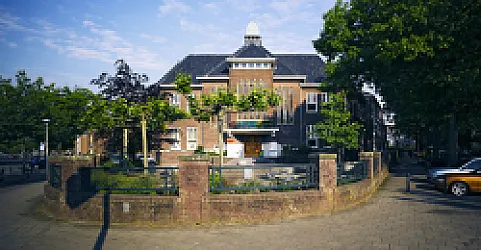Visitez Nimègue en 2 jours
12 POIs incontournables, parcours optimisés et anecdotes.
Chargement de la carte...
Vous allez visiter les plus beaux points d'intérêt de Nimègue
2 Days in Nijmegen — A short love letter to the oldest Dutch city
Nijmegen stole my heart the moment I stepped off the train. This city, often called the oldest city in the Netherlands, feels like a warm, lived-in story. Some people whisper that it’s overrated, but for me the charm is undeniable. I still remember tracing the worn stones near the Latin School and feeling time fold. I’ve returned twice, and each visit revealed a new secret.
Why visit? Nijmegen is more than its history. It hums with student energy, river breeze, and unexpected art tucked in alleys. You’ll stroll past the stately Karel de Grote College, get delightfully lost in the Labyrinth, and stand quietly outside the Latin School, imagining scholars from centuries ago. The city smells faintly of fresh bread and coffee in the mornings. You’ll hear church bells and laughter from terraces. This is the kind of place where architecture and everyday life mingle, and every corner asks, “Want to stay a little longer?”
Planning a trip can feel overwhelming. There’s so much to see that you could easily spend weeks exploring. I get it—time is limited, and you want to make every hour count. That’s exactly why I put together this compact Nijmegen itinerary for busy travelers. Below, I’ll show you how to make the most of those precious 48 hours without rushing. You’ll cover historic sites, playful installations, and the city’s character-packed streets.
Key tip: Start early and wander late. Mornings are calm at the Latin School and Karel de Grote College. Evenings bring a softer light and livelier terraces by the river. This pacing avoids crowds and lets you feel the city’s rhythm. It also gives you time to linger at the Labyrinth, soak in sculptures, and enjoy small discoveries without stress. Now let’s dive into the itinerary!

Quick Mini Guide to Nijmegen
Where to stay:
- Valkhof/Old Town — walkable to Roman ruins, Latin School and riverside terraces.
- Waalkade — riverside hotels for sunset views over the Waal and easy boat access.
- Near Nijmegen Central — best if you arrive by train and want quick access to bike rental.
When to visit:
- Late spring–early summer for warm terrace weather and blooming Valkhof Park.
- Mid July if you want the Vierdaagse atmosphere — expect crowds and book early.
- Weekdays for quieter museum visits and easier bookings for interactive tours.
Things to do:
- Morning: stroll Valkhof Park, see Roman remains then photograph the historic Latin School (Nijmegen).
- Afternoon: seek out the Labyrinth installation and nearby indie galleries; combine with a Waalkade walk.
- Evening: book The Alchemist NIJMEGEN — immersive cocktail/experience — and reserve ahead.
- Day 2: visit Karel de Grote College exterior (architectural interest), explore student streets and markets; finish with Peter Pan Nijmegen interactive tour.
Don't forget:
- Comfy shoes for cobbles and hillier Valkhof routes; bring a light rain layer.
- Book The Alchemist NIJMEGEN and Peter Pan Nijmegen in advance — limited slots.
- Grab a local beer on the Waalkade and check opening times for the Latin School and Karel de Grote College if you want an interior visit.
Jour 1 - Nimègue
6 POIs à découvrirJour 1 - Matin à Nimègue
5 Points d'intérêt - Durée : 3h00 - Distance : 0.8 km - Marche : 0h11
Labyrinthe
- L'œuvre d'art, faite de pierre de basalte, est située dans un bassin plus profond que le reste de la Waalkade, conçu pour interagir et vivre.
- Reliant la ville à la rivière, le Labyrinthe comporte des canaux d'eau et des allées, soulignant la relation entre la terre et l'eau.
- La forme extérieure du Labyrinthe est un cercle de 24 mètres de diamètre, et le canal et le sentier s'étendent sur 350 mètres.
- Distinct d'un labyrinthe, un labyrinthe a un chemin non ramifié menant au point final, et cette création artistique reflète ce concept.
- Klaus van de Locht (1942-2003), né à Millingen, n'était pas seulement sculpteur, mais aussi peintre.
- Il s'est installé à Nimègue en 1974 et est décédé en 2003.
Anthonispoort
- La Sint Anthonis ou Maarten Schenckpoort est l'une des rares portes de la ville de Nimègue encore debout, permettant d'accéder à la ville depuis la Waalkade.
- En 1589, Maarten Schenck assiégea Nimègue au nom de la République.
- Une tentative de prendre la ville par Sint Anthonispoort échoua car les citoyens de Nimègue l'affrontèrent et le repoussèrent.
- Les citoyens, qui attendaient à la porte, forcèrent Schenck et ses troupes à une retraite paniquée.
- Malheureusement, Maarten van Schenk s'est noyé dans la rivière lorsque son bateau s'est renversé en raison de sa lourde armure.
- Comme acte de vengeance, son corps décapité et démembré a été exposé - la tête à Sint Anthonispoort et les parties restantes à d'autres portes comme un moyen de dissuasion.
- En 1591, lorsque Maurits van Nassau s'empara de la ville, il s'assura que Maarten van Schenk soit enterré avec honneur dans le Sint Stevenskerk.

Hôtel de ville de Nijmegen
- L'hôtel de ville de Nimègue, bâtiment historique de style première Renaissance, a été construit en 1554-1555 sous la direction de Herman van Herengrave.
- L'hôtel de ville abrite de nombreuses œuvres d'art historiques et modernes.
- De 1879 à 1882, l'hôtel de ville a été restauré par l'architecte Pierre Cuypers, qui a agrandi le bâtiment du côté ouest et a fait des copies des sculptures de la Renaissance sur la façade.
- Il subit des dommages considérables lors d'un bombardement en 1944 et de l'incendie qui s'ensuivit, mais ses façades avant et latérales furent préservées et restaurées de 1947 à 1953.
- Pendant cette période de restauration, l'aile ouest construite par Cuypers fut remplacée par une aile de style moderne ; une tour en brique avec un sommet en forme d'oignon fut également ajoutée.
- Les éléments clés à l'intérieur de l'hôtel de ville comprennent une collection de tapisseries du 17ème siècle qui ont été achetées pour les négociations qui ont conduit à la Paix de Nimègue en 1678-1679.

Grote de Sint-Stevenskerk
- La Grande Église ou Sint-Stevenskerk est la plus ancienne et la plus grande église de Nimègue, dans la province néerlandaise de Gelderland.
- L'histoire de l'église remonte au VIIe siècle, peut-être liée à la campagne de christianisation de l'évêque Kunibert de Cologne.
- L'église actuelle a été consacrée en 1272 par Albertus Magnus et est passée administrativement sous l'autorité du chapitre de l'Église des Apôtres de Cologne.
- L'église a subi des agrandissements à plusieurs reprises entre le 13e et le 16e siècle, notamment l'ajout d'un impressionnant déambulatoire.
- En 1591, l'église est devenue définitivement protestante, à l'exception d'un bref intermède catholique vers 1670.
- Aujourd'hui, le bâtiment est principalement utilisé pour des services religieux œcuméniques hebdomadaires, des concerts d'orgue, des expositions, des activités d'associations étudiantes, et des discours.

École latine (Nijmegen)
- L'école De Latijnse est une ancienne école apostolique ou école latine.
- L'école a été construite vers 1544-1545 par l'architecte Herman van Herengrave, dans un style de la première Renaissance.
- En 1842, l'école latine a été transformée en gymnase, le Stedelijk Gymnasium Nijmegen.
- Plusieurs institutions se sont installées dans le bâtiment après le gymnase.
- Le bâtiment a été restauré en 1965 et abrite depuis un cabinet de conseil en urbanisme.
- Aujourd'hui, le bâtiment est un monument de l'État et porte le numéro 31170.
Jour 1 - Après-midi à Nimègue
1 Points d'intérêt - Durée : 0h45 - Distance : 0 km - Marche : 0h00
Karel de Grote College
- Karel de Grote College is a vocational-technical school in Nijmegen, Netherlands.
- It offers programs in a wide variety of fields, including business, engineering, hospitality & tourism, health care, computer science, and media & communication.
- With over 8,000 students and approximately 400 teachers, Karel de Grote College is one of the largest vocational-technical schools in the Netherlands.
- The school is known for its innovative approach to education and its emphasis on providing students with practical experience in their chosen field.
- Karel de Grote College also has a strong emphasis on internationalization and has exchange programs with many universities around the world.
Jour 2 - Nimègue
6 POIs à découvrirJour 2 - Matin à Nimègue
5 Points d'intérêt - Durée : 3h00 - Distance : 0.8 km - Marche : 0h11
Labyrinthe
- L'œuvre d'art, faite de pierre de basalte, est située dans un bassin plus profond que le reste de la Waalkade, conçu pour interagir et vivre.
- Reliant la ville à la rivière, le Labyrinthe comporte des canaux d'eau et des allées, soulignant la relation entre la terre et l'eau.
- La forme extérieure du Labyrinthe est un cercle de 24 mètres de diamètre, et le canal et le sentier s'étendent sur 350 mètres.
- Distinct d'un labyrinthe, un labyrinthe a un chemin non ramifié menant au point final, et cette création artistique reflète ce concept.
- Klaus van de Locht (1942-2003), né à Millingen, n'était pas seulement sculpteur, mais aussi peintre.
- Il s'est installé à Nimègue en 1974 et est décédé en 2003.
Anthonispoort
- La Sint Anthonis ou Maarten Schenckpoort est l'une des rares portes de la ville de Nimègue encore debout, permettant d'accéder à la ville depuis la Waalkade.
- En 1589, Maarten Schenck assiégea Nimègue au nom de la République.
- Une tentative de prendre la ville par Sint Anthonispoort échoua car les citoyens de Nimègue l'affrontèrent et le repoussèrent.
- Les citoyens, qui attendaient à la porte, forcèrent Schenck et ses troupes à une retraite paniquée.
- Malheureusement, Maarten van Schenk s'est noyé dans la rivière lorsque son bateau s'est renversé en raison de sa lourde armure.
- Comme acte de vengeance, son corps décapité et démembré a été exposé - la tête à Sint Anthonispoort et les parties restantes à d'autres portes comme un moyen de dissuasion.
- En 1591, lorsque Maurits van Nassau s'empara de la ville, il s'assura que Maarten van Schenk soit enterré avec honneur dans le Sint Stevenskerk.

Hôtel de ville de Nijmegen
- L'hôtel de ville de Nimègue, bâtiment historique de style première Renaissance, a été construit en 1554-1555 sous la direction de Herman van Herengrave.
- L'hôtel de ville abrite de nombreuses œuvres d'art historiques et modernes.
- De 1879 à 1882, l'hôtel de ville a été restauré par l'architecte Pierre Cuypers, qui a agrandi le bâtiment du côté ouest et a fait des copies des sculptures de la Renaissance sur la façade.
- Il subit des dommages considérables lors d'un bombardement en 1944 et de l'incendie qui s'ensuivit, mais ses façades avant et latérales furent préservées et restaurées de 1947 à 1953.
- Pendant cette période de restauration, l'aile ouest construite par Cuypers fut remplacée par une aile de style moderne ; une tour en brique avec un sommet en forme d'oignon fut également ajoutée.
- Les éléments clés à l'intérieur de l'hôtel de ville comprennent une collection de tapisseries du 17ème siècle qui ont été achetées pour les négociations qui ont conduit à la Paix de Nimègue en 1678-1679.

Grote de Sint-Stevenskerk
- La Grande Église ou Sint-Stevenskerk est la plus ancienne et la plus grande église de Nimègue, dans la province néerlandaise de Gelderland.
- L'histoire de l'église remonte au VIIe siècle, peut-être liée à la campagne de christianisation de l'évêque Kunibert de Cologne.
- L'église actuelle a été consacrée en 1272 par Albertus Magnus et est passée administrativement sous l'autorité du chapitre de l'Église des Apôtres de Cologne.
- L'église a subi des agrandissements à plusieurs reprises entre le 13e et le 16e siècle, notamment l'ajout d'un impressionnant déambulatoire.
- En 1591, l'église est devenue définitivement protestante, à l'exception d'un bref intermède catholique vers 1670.
- Aujourd'hui, le bâtiment est principalement utilisé pour des services religieux œcuméniques hebdomadaires, des concerts d'orgue, des expositions, des activités d'associations étudiantes, et des discours.

École latine (Nijmegen)
- L'école De Latijnse est une ancienne école apostolique ou école latine.
- L'école a été construite vers 1544-1545 par l'architecte Herman van Herengrave, dans un style de la première Renaissance.
- En 1842, l'école latine a été transformée en gymnase, le Stedelijk Gymnasium Nijmegen.
- Plusieurs institutions se sont installées dans le bâtiment après le gymnase.
- Le bâtiment a été restauré en 1965 et abrite depuis un cabinet de conseil en urbanisme.
- Aujourd'hui, le bâtiment est un monument de l'État et porte le numéro 31170.
Jour 2 - Après-midi à Nimègue
1 Points d'intérêt - Durée : 0h45 - Distance : 0 km - Marche : 0h00
Karel de Grote College
- Karel de Grote College is a vocational-technical school in Nijmegen, Netherlands.
- It offers programs in a wide variety of fields, including business, engineering, hospitality & tourism, health care, computer science, and media & communication.
- With over 8,000 students and approximately 400 teachers, Karel de Grote College is one of the largest vocational-technical schools in the Netherlands.
- The school is known for its innovative approach to education and its emphasis on providing students with practical experience in their chosen field.
- Karel de Grote College also has a strong emphasis on internationalization and has exchange programs with many universities around the world.
Where to Stay in Nijmegen
For a short two-day visit to Nijmegen, location matters more than frills: you want to spend your time exploring, not commuting. A base close to the compact old town lets you walk to the main sights, evening cafés and riverside views, while a spot near public transport makes quick side-trips or airport/train connections painless. Think in terms of being within easy walking or cycling distance of the places on your list so you can use your limited time for the city itself.
The city is organized around the historic center on the southern bank of the Waal and the residential areas that fan out from it. The heart of activity sits around the Grote Markt and Stevenskerk; the green Valkhof park and its viewpoints sit just north of the center, and the village-like district of Lent lies across the river. Beyond the center you’ll find quieter, lived-in neighborhoods — handy if you prefer calm evenings — while the train station anchors reliable connections to the rest of the Netherlands.
If your priority is the historic school buildings such as the Latin School, aim for the Centrum so you can be close to old streets, museums and the best café terraces. For attractions near the river or something like the Labyrinth experience, neighborhoods by the Valkhof or on the north bank in Lent put you a short walk or a pleasant ferry ride away. If your visit involves the Karel de Grote College or other institutions slightly east of the center, consider a stay in Nijmegen-Oost or Bottendaal — residential, well connected and quieter in the evenings.
Transport in Nijmegen is forgiving: the city is eminently walkable and superb for cycling, with short distances between neighborhoods. Staying near Nijmegen Centraal means easy arrivals and departures, plus straightforward bus links (Breng) to suburbs. There’s also a regular pedestrian/cycle ferry across the Waal, which can save you time and make a scenic part of your commute. For two days, a simple OV-chipkaart or a day ticket is usually all you need.
Choose accommodation with location and flexibility in mind: a small guesthouse or apartment in a quiet street close to the center will feel spacious and save travel time. Prioritize a nearby station or ferry if you value convenience, or a riverside spot if you want atmosphere. With a sensible location, two days in Nijmegen will feel relaxed and effortless — you’ll have time to wander, to find favorite cafés, and to enjoy the city’s compact charm.
Getting Around Nijmegen
Public transport in Nijmegen is refreshingly straightforward, even if it’s your first time in the Netherlands. The city is served by regional trains at Nijmegen Centraal and a dense network of local buses usually branded as Breng, with long-distance connections by NS. Services are frequent, stops are clearly marked, and announcements are usually in both Dutch and English, so you don’t need to be a local to feel confident. The compact city center means many places are also pleasantly walkable, so public transport often shortens a trip that would otherwise be a long walk with luggage.
A practical tip: use an OV-chipkaart if you plan to ride more than once, or grab a disposable one for a short stay. You can also often tap with a contactless bank card or phone on trains and many buses, but I like having an OV-chipkaart tucked away for peace of mind. If you only take a single bus, you can usually buy a ticket from the driver or from machines at the station. Single rides in the city are inexpensive (around a few euros), and there are day tickets and regional passes if you plan heavy travel—check the local operator before you buy. 🎫
When it comes to planning, Google Maps is a reliable companion and often gives live departure times and platform info; for the most granular local options use 9292 or the Breng/NS apps. Enter your current location and your destination (for example, “Karel de Grote College” or “Latin School Nijmegen”) and you’ll get step-by-step directions with walking time to the stop, the bus number, and the stop to get off at. Stops around the center show digital timetables, and drivers are friendly if you ask for confirmation of the stop name—people here tend to help tourists gladly. 🗺️
You’ll save money by combining walking or cycling with occasional bus rides—Nijmegen is one of the Netherlands’ most cycle-friendly cities, so renting a bike for part of your stay is cost-effective. If you expect multiple journeys in one day, look into a day pass or a regional ticket; otherwise the pay-as-you-go OV-chipkaart or contactless payment keeps things simple. Small choices like avoiding peak commuter times can also shave off a bit from longer regional trips.
I remember the first time we went from the Karel de Grote College to the Labyrinth: I checked Google Maps, walked three minutes to the nearest Breng stop, tapped my OV-chipkaart as the bus pulled up, and enjoyed a five-minute ride before hopping off and strolling a short block to the Labyrinth. Later that day we walked between the Labyrinth and the Latin School because it was quicker than waiting for the next bus—easy, flexible, and a little adventure every time. You’ll find getting around Nijmegen feels the same—friendly, efficient, and low-stress. 💡🚇
What to Pack for Nijmegen
I love Nijmegen for its compact historic centre, riverside walks along the Waal and surprising sculptures tucked into side streets. On a two-day trip you’ll be on your feet a lot—I once walked about 15 miles (24 km) over 2 days, out for 10+ hours each day—so I pack light but smart. Below are the essentials I always bring and why each one saved me more than once.
1. Comfortable walking shoes (Ecco Soft 7 or similar): I learned the hard way that pretty shoes don’t cut it—cobblestones around the Valkhof and long riverside promenades demand supportive soles. My Ecco Soft 7 sneakers gave me stable arches and soft midsoles for a full day; if you expect rain, swap to Gore‑Tex trainers like Salomon X Ultra 3 GTX. Why it matters: prevents blisters, keeps you exploring for 10+ hours without hobbling.
2. Weather‑appropriate layering + waterproof jacket: Nijmegen weather can flip from sun to drizzle in an afternoon. I always pack a thin merino base layer, a light fleece, and a compact waterproof shell. Once I was sightseeing for 8 hours when a sudden shower hit—my packable jacket kept me warm and the rest of my clothes dry. Why it matters: comfort and flexibility for outdoor architecture walks and sculpture hunts.
3. Cross‑body bag (anti‑theft, ~5–7L): I use a small cross‑body with a hidden zip and bottle pocket. It fits my phone, wallet, city map, and a compact camera. On busy streets near the market I felt safer than with a backpack; I once kept a small camera snug and accessible for spur‑of‑the‑moment photos. Why it matters: secure, hands‑free and quick access while you’re moving between monuments and installations.
4. Euro power adapter (Type C/E/F) + knowledge of 230V: Charge your phone, camera, and headphones overnight. I found a single adapter that took 2 devices and avoided hunting for sockets after a long day of wandering (I was charging for 30–60 minutes between outings). Why it matters: essential to keep devices alive for maps, tickets and photos.
5. Power bank (10,000 mAh): For long days away from your hotel I carry a 10,000 mAh bank—enough for ~2 full phone charges. Once my phone dropped to 5% in the middle of a long self‑guided architecture walk; the power bank got me back to 60% so I could finish navigation and take evening photos. Why it matters: peace of mind when you’re out 8–12 hours and relying on maps and photos.
6. Optional — compact umbrella or refillable water bottle: If you expect showers, a small umbrella saved me from soggy notes. Alternatively, a 500 ml refillable bottle kept me hydrated during long sculpture-watching sessions without buying plastic. Why it matters: small comforts that make wandering more pleasant and sustainable.
Enjoy Your Trip to Nijmegen!
Two days in Nijmegen, three carefully chosen spots—packed with charm and curiosity. From the twisting Labyrinth to the historic Latin School (Nijmegen) and the striking Karel de Grote College, this itinerary gives you everything you need to soak up local history, architecture, sculptures and playful installations. It’s upbeat, easy to follow, and full of the city’s best surprises.
Remember, this is a guide, not a strict schedule. Embrace a relaxed pace and leave room for the unexpected: the real magic often happens when you wander off the map, chat with a local, get delightfully lost among historic streets, or pause for an unplanned café stop. Don’t feel pressured to see EVERYTHING—slow down, enjoy the monuments and installations, and let curiosity lead your two days.
I hope you feel excited and confident—I'm genuinely excited for you! Embrace each view, sculpture and architectural detail, and collect unforgettable memories in Nijmegen’s urban tapestry. You’re going to love the mix of history, playful installations and quiet corners; come back with stories and a full heart.
Want to explore in a playful way? Check out the interactive Coddy tours—The Alchemist NIJMEGEN and Peter Pan Nijmegen—perfect for turning city discovery into a gamified adventure. They’re a fun, easy way to see familiar spots anew and add laughter to your two-day plan.
Enjoy! Safe travels! If you want, share your stories or ask any last questions—I’ll be cheering for your Nijmegen adventure!
Envie de plus d'aventure ?
Découvrez nos jeux d'évasion urbains pour transformer votre visite en aventure interactive !



















